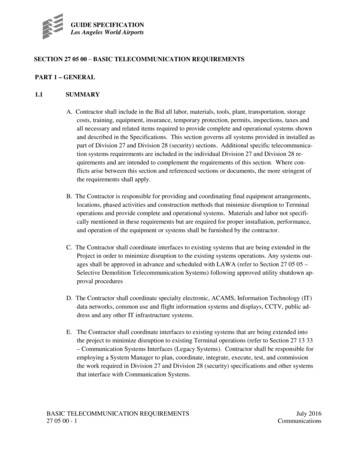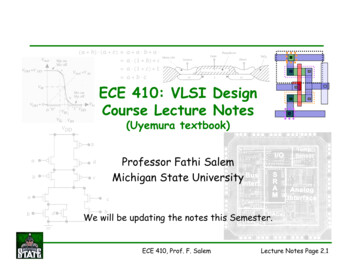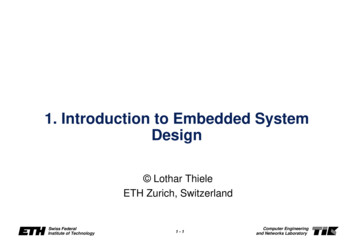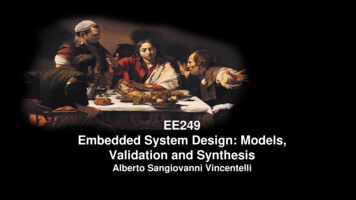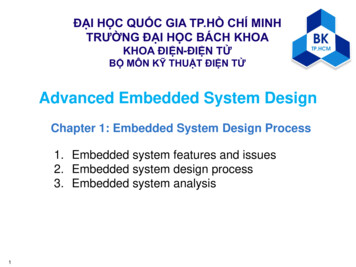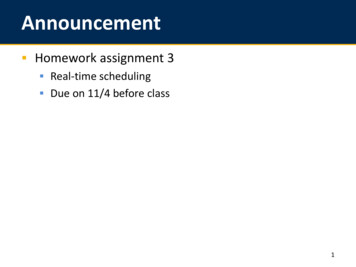
Transcription
Announcement Homework assignment 3 Real-time scheduling Due on 11/4 before class1
ECE 1175Embedded System DesignReal-Time Scheduling - IIWei Gao2
Comparison Schedulability RMS may not guarantee schedulability even when CPU isnot fully utilized EDF can guarantee schedulability as long as CPU is not fullyutilized Overhead RMS: low overhead, priorities are never changed EDF: higher overhead, task priorities may need to bechanged online Optimality RMS: optimal static priority scheduling algorithm EDF: optimal dynamic priority scheduling algorithm3
Relaxing Assumptions Single processor.All tasks are periodic.Zero context switch time.Relative deadline period.No priority inversion. What if priority inversion exists?4
Priority Inversion A lower-priority task blocks a higher-priority taskfrom running. Sources of priority inversion Access shared resources guarded by semaphores Lower-priority task gets the resource first Access non-preemptive subsystems Communication subsystems Storage5
Priority Inversioncritical sectionT1 blocked!14014241468104121416182022T1 tries to get the same semaphoreT4 preempted by T1T4 acquires a semaphoreT4 starts to run6
Unbounded Priority Inversioncritical sectionT1 blocked by 4,2,3!11123404244468101214164182022T1 tries to get the semaphore7
Solution: Priority Inheritance Let the low-priority task inherit the priority of theblocked high-priority task.critical sectionT1 only blocked by 41113240424446810121416182022T4 returns to priority 4 after the critical sectionT1 tries to get semaphore so T4 inherits T1’s priority8
Real Incident Mars Pathfinder Priority inversion on Mars http://www.cse.chalmers.se/ risat/Report MarsPathFinder.pdf https://www.youtube.com/watch?v lyx7kARrGeM9
Relaxing Assumptions Single processor.All tasks are periodic.Zero context switch time.Relative deadline period.No priority inversion. (relaxed) What if we have multiple processors?10
End-to-End Task Model An (end-to-end) task is composed ofmultiple subtasks running on multipleprocessors Message/event Remote method invocation Subtasks are subject to precedenceconstraints Task a chain/tree/graph of subtasks E.g. ship vigation11
Notation Ti {Ti,1, Ti,2, , Ti,n(i)} n(i): the number of subtasks of Ti Precedence constraint: Job Ji,j cannot be releaseduntil Ji,j-1 is completed.Task TiSonarSubtasks: ationTi,412
End-to-End Scheduling Framework1.2.3.4.Task allocationSynchronization protocolSubdeadline assignmentSchedulability analysis13
Task Allocation Load code (e.g., objects) to processors Strategies Offline, static allocation subject to resource availability Allocate a task when it arrives dynamically Re-allocate (migrate) a task after it starts Optimal solutions for maximum schedulability How to meet all deadlines in an optimal way? E.g., minimize the number of needed processors NP-hard: heuristics needed14
Bin Packing for Task Allocation Pack subtasks to bins (processors) withlimited capacity Size of a subtask Utilization: Ci,j/Pi Capacity of each bin is its utilizationbound Goal: minimize the number of binssubject to the capacity constraintsT1T2T3T1T2 15
End-to-End Scheduling Framework1.2.3.4.Task allocationSynchronization protocolSubdeadline assignmentSchedulability gationAfter a subtask is finished, should thenext subtask start immediately or waitfor a while?16
Greedy Protocol After a subtask is finished, the next subtask startsimmediately Release job Ji,j;k as soon as Ji,j-1;k is completed Subsequent subtasks may not be periodic under agreedy protocol Difficult for schedulability analysis High-priority tasks arrive early high worst-case responsetime for lower-priority ion17
Greedy ProtocolIllustrated Task: (C,P)T1T2,1On P1T1 (2,4)T2,2 (2,6)P1P2T2,1 (2,6)T3 (4,7)P12468101224681012246810122481012T3’s deadlineP2On P2T2,2T36T3 starts hereT3missesdeadline18
Properties of Greedy Protocol Low overhead Low average response time Difficult schedulability analysis Subsequent subtasks are no longer periodic High worst-case response time19
Release Guard After a subtask is finished, the next subtask may wait for awhile before release Every subtask (if not a first subtask) has a release guard, which waits for the preceding subtask for a result/event then releases the job at the point of exact one period from the last release time (Rule1)OR whenever the processor becomes idle (Rule 2) Release guard strategy improves worst response time withoutaffecting schedulability20
Release GuardIllustrated Task: (C,P)T1T2,1On P1T3T2,2 (2,6)P1P2T2,1 (2,6)T3 (4,7)2468101224681012On P2T2,2T1 (2,4)Next release 4 6 10242466T3 starts hereP1P2Release guard releases the job8101281012T3’s deadlineT3 meetsdeadline21
End-to-End Scheduling Framework1.2.3.4.Task allocationSynchronization protocolSubdeadline assignmentSchedulability analysis22
Subdeadline Assignment Algorithms Notation (Relative) deadline Di of task Ti (Relative) subdeadline Dij of subtask Tij (1 j n(i)) Ultimate Deadline (UD): Dij Di Example An end-to-end task T1, with deadline as 12, has 4 subtasks: T11,T12, T13 and T14 with execution times as: 3, 1, 1, 1. D11 D12 D13 D14 D1 12 But T11, T12, T13 must finish earlier than the end-to-enddeadline such that T14 can have time to run.23
Common Assignment Algorithms Proportional Deadline (PD): Assign deadline proportionally to execution timeCijDij Di n (i ) k 1 Cik Example An end-to-end Task T1, with deadline as 12, has 4 subtasks T11, T12, T13 and T14 with execution time as: 3, 1, 1, 1.D11 12 * 3/(3 1 1 1) 6D12 12 * 1/(3 1 1 1) 2D13 12 * 1/(3 1 1 1) 2D13 12 * 1/(3 1 1 1) 224
End-to-End Scheduling Framework1.2.3.4.Task allocationSynchronization protocolSubdeadline assignmentSchedulability analysis Decide an appropriate scheduling algorithm RMS, EDF, etc For each processor, conduct uniprocessor schedulabilityanalysis Then synchronize among multiple processors25
Summary End-to-end scheduling framework Task allocation Bin packing Synchronization protocol Greedy protocol, release guard Subdeadline assignment Ultimate deadline, proportional deadline Schedulability analysis26
Reading Priority inversion on Mars http://www.cse.chalmers.se/ risat/Report MarsPathFinder.pdf https://www.youtube.com/watch?v lyx7kARrGeM27
Wei Gao. ECE 1175 Embe




